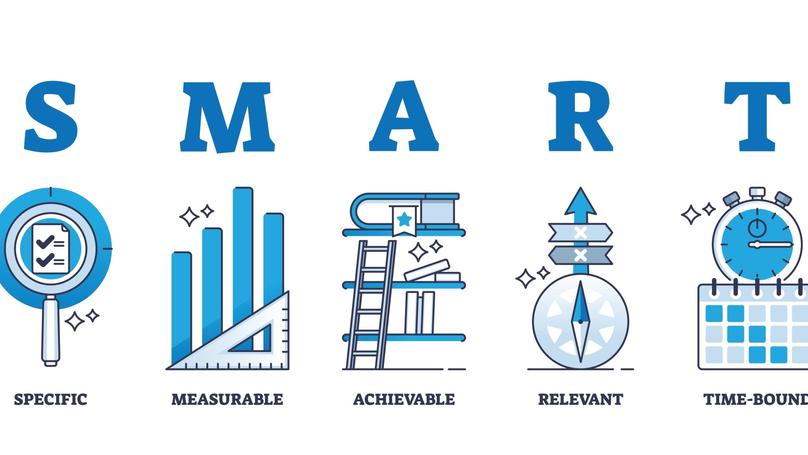SMART Goals

What are SMART goals?
SMART is a particular management method for setting goals and objectives. The main idea is to transform abstract and unclear goals into ones that are clear, specific, and truly achievable for all team or project group members.
The SMART method is an effective tool for defining KPIs and the particular steps to achieving goals. It simplifies the assessment of a project's progress and tracking the key indicators whilst enhancing them and facilitating team collaboration and personnel management. Essentially, to define, SMART goals help structure the work process and make it more effective by setting clear and specific tasks. Traditional management methods struggled to address this need. Consequently, in the 1960s and 70s, companies faced unclear results, decreased employee motivation, and reduced productivity, so they started to develop new project management and strategic planning methods.
The SMART methodology, used to describe strategic objectives, was first described and proposed by American business consultant George T. Doran in 1981. He also coined the name SMART. It is actually an acronym that encapsulates the main standards for a goal:
-
S - specific;
-
M - measurable;
-
A - achievable;
-
R - relevant;
-
T - time-bound.
More about SMART criteria
We've already established a general understanding of what a goal should be. Now, let's delve deeper into the meaning of each principle.
Specific - Indicates that the goal should be as precise as possible. This means it should be formulated in a way that all team members understand it uniformly, without needing further explanation. Therefore, before setting a goal, ensure it is not open to multiple interpretations.
Measurable - This requires an exact method to determine if the goal has been achieved. The results, regardless of what they are, must have clear assessment conditions. Ideally, quantify what needs to be completed by numbers. For example, if the task is to increase the average customer spend, specify the percentage increase desired. This approach not only helps assess how well the goal was met-whether fully or partially-but also informs future tasks based on the experience gained.
Achievable or attainable - In other words, the goal should be doable, feasible, and realistic. It's important to establish whether the set goal can be reached with the resources currently available. If not, adjustments to the goal's wording or its essence are necessary. Additionally, this decisive factor requires that the goal is achieved within a realistic timeframe. For example, if it previously took 3-4 months to improve a certain metric, it would be unrealistic to expect the same improvement in just two weeks, making such an objective unattainable from the outset.
To gauge how achievable a goal is both overall and within a particular timeframe, refer to statistics and compare the set task with the average data for your industry or company. You can also rely on previous experience, but to consistently improve metrics while staying competitive, consult market figures.
Relevant - in this context, "relevant" means that the SMART goal should align with the company's overarching objectives and assist in fulfilling its mission. For instance, if a company aims to enter a new market and enhance its recognition among a new audience, each goal set should contribute to achieving this primary objective.
Time-bound - The goal must have a specific, time-bound deadline. Optimal deadlines for SMART goals are typically three, six, or twelve months, depending on the company's scale and the goal's ambition. Setting too short a period, such as two weeks or a month, is unlikely to yield significant results, while a longer period, such as several years for a small goal, may cause it to lose its relevance. Without any deadline, employees are likely to procrastinate, prioritising more immediate and understandable tasks instead.
Crafting a SMART goal

To accurately devise a goal using the SMART method, adhere to these general recommendations:
Tip #1. Conduct repeated market research
To clearly define your objectives and the means to achieve them, study your product, the company's overall performance metrics, and the competitive market environment. Identify strengths, weaknesses, external threats, opportunities, and growth points. It's advisable to employ another technique during this research - SWOT analysis. We've already provided details on how to use it properly here.
Tip #2. Develop several goals
After conducting a SWOT analysis, you must immediately identify several problems, potential threats, and growth opportunities. It's crucial to define one goal for each position. For example, increasing the average spend can be the first task, boosting the number of sales can be the second, and reducing negative reviews by 20% can be the third. Avoid mixing different goals into one generalised objective. If a goal is too broad, the chances of achieving it are significantly lower. Therefore, it's better to break such tasks into stages and distribute them among employees. Having multiple clear, precise, and realistically achievable goals is more effective.
Tip #3. Ask questions
When setting goals, ask as many questions as possible to create the most specific and understandable tasks. Questions like "What do we want to achieve?", "How can this be done?", "What should we do first?", "What resources will be needed?" and "What could prevent us from achieving the goal?" are crucial to be asked by you and your colleagues. As a result, your goal should provide a clear answer for what needs to be done. For example, increase revenue to $100,000 per month, secure contracts with three large distributors, and attract two influencers for collaboration.
Tip #4. Focus on achieving one result
Each goal should focus on achieving a single result rather than multiple outcomes simultaneously. For example, if the task is to increase the average spend, don't expect an immediate increase in overall revenue.
Tip #5. Assign responsibility for each goal
Even though the entire team, group, or project collective works toward the goal, it is essential to assign an individual responsible for each stage of implementation and the final results. Without this, employees might shift responsibility onto each other, resulting in no one being accountable for the outcomes. The same principle applies to deadlines. Without setting particular deadlines, there's a high risk that all the work will be rushed and completed at the last minute.
Tip #6. Track progress
Larger tasks may also have intermediate deadlines in addition to the final deadline. During these periods, the manager can check on the work's progress and the results achieved so far. Periodic monitoring allows for adjustments to deadlines or even the goal itself if conditions, resources, or other inputs change.
Tip #7. Be flexible and ready to adapt your plans
Embracing change and being ready to adapt plans, goals, or deadlines in response to new circumstances is crucial. To stay open to innovation, you should develop alternatives in advance and create multiple strategies for achieving your goals. Provide yourself with the ability to quickly switch to a new action plan if the current one becomes irrelevant. Unexpected risks and abrupt changes in plans can sometimes lead to success. The key is to remain flexible, swiftly adjust goals and ways to achieve them, and avoid wasting resources.
Tip #8. Always record agreements
Devised goals, exact deadlines, and details of responsible persons should be entered into work organisers. Additionally, any changes made to the work process should be recorded there. You can use multifunctional applications like Any.do, Jira, Todoist, or the simplest tool-Google Calendar.
Tip #9. Draw conclusions
It's essential to examine both the intermediate and final results of the work. Determine whether the available resources were sufficient to achieve the intended plan, identify which aspects could not be fulfilled, or understand the factors that led to exceeding the plan. Additionally, pinpoint any key mistakes. You might have overestimated the company's capabilities or underestimated competitors. This experience will help you set more effective and achievable goals in the future, avoid similar shortcomings, and consistently achieve your objectives.
Advantages and disadvantages of SMART goals

The advantages of the SMART method are obvious:
-
Simplicity and accessibility - With the necessary conditions and details, formulating a goal using the SMART technique is straightforward and doesn't require much time;
-
Ease of use - This method enables you to break down large goals into more precise and comprehensible tasks, structure the work around them, and establish a clear sequence for implementation;
-
Transparency - Setting goals following specified criteria simplifies many processes, eliminates various disputes and misunderstandings, and ensures clarity of tasks for all team members;
-
Prompt progress tracking - An integral component of SMART is the use of precise KPIs, clear formulations, and designated deadlines. These elements enable the monitoring of interim results, the control of all procedures, and the ability to make real-time adjustments;
-
Effective project and team management - Using this method, managers can effectively distribute tasks and motivate employees to achieve their goals. Additionally, the SMART technique helps the team understand the overarching objective, the expected results from management, and the most efficient ways to apply plans in the shortest time possible;
-
Universality - The SMART technique is well-suited for setting a wide variety of tasks, including short-term and long-term strategic goals, in both everyday life and professional activities. It is utilised in marketing, sales, coaching, production, and even for personal objectives.
However, the SMART methodology also has its drawbacks, or rather limitations. It is challenging to apply in creative industries, where results are difficult to measure quantitatively. Additionally, this technique is not suitable for projects with frequently shifting deadlines and rapidly changing input data, as SMART may not be able to keep pace with such changes.
Another drawback of the SMART method is its excessive focus on the final result, which can lead to tension and additional stress, leaving no room to enjoy the process of achieving the goal. In some areas, this can be crucial. Additionally, the methodology is often criticised for ignoring qualitative aspects. SMART goals focus predominantly on quantitative indicators, and the goals achieved may not meet quality requirements.
Examples of SMART goals

As we've discovered, this method is versatile and can be applied to various activities. Let's explore several examples of how to use the SMART technique in both business and personal life.
For instance, if your goal is to improve sales results, you can evaluate it using the listed criteria with a simple template:
-
S. What exactly do you want to achieve? Let's refine the goal to increase the number of sales through promotional offers.
-
M. By how many per cent do you need to increase your sales? Analyse the statistics and compare the data with the results from the previous month, quarter, or half-year. Remember, the goal must be achievable. Therefore, you aim to increase the number of sales through promotional offers by 20%.
-
A. Now, ensure you have all the necessary resources and production capacities to achieve the goal. Consider external risks, threats, and other circumstances that may hinder you. You might discover that a competing company is also running promotions simultaneously, making it challenging to increase sales by 20% immediately. In this case, adjust the goal slightly. For example, aim to increase sales by 15%. This way, the task will be realistically achievable.
-
R. Consider the prospects for achieving the goal: What benefits will it bring? For instance, it could allow the company to generate additional profit, which can be used to purchase new production equipment, improve product features, or release an updated version.
-
T. Set a deadline for achieving your goal. For instance, aim to increase sales within two months, by January 2025.
Therefore, you have transformed an abstract and vague goal into a highly specific one: increase the number of sales of a certain product by 15% using promotional offers by January 2025.
Using the same approach, you can develop any task to help you achieve your goals. For example, if you want to improve relationships between team employees but need to know how to accomplish this, start by setting a goal using the SMART method. You might end up with a task like conducting a survey of team members within two weeks to identify areas of dissatisfaction, addressing the negative factors, and then running another study to compare the results. This makes the goal much clearer.
If you want to increase the number of followers on social media, establish how to achieve this and specify the exact number of followers you are aiming for according to each SMART criterion. You might set a goal like this: increase the number of followers on a particular social media to one hundred thousand within three months (by February 2025) by publishing video content twice a week.
Now, let's explore a couple of examples of how to use SMART for personal goals. For instance, if you want to lose weight and aim to shed 20 kg in two weeks, you will likely need more time to achieve this goal. Instead, to set a realistic goal, you formulate it like this: lose 10 kg in six months through a diet recommended by a nutritionist and physical activity three times a week.
If you want to save a particular amount of money but find yourself making impulsive purchases, it might be because you need a clear idea of what you're saving for. So, first, determine your savings goal. Then, adjust your goal to fit the SMART criteria: save five thousand dollars for a vacation in Europe by setting aside 30% of your salary for the next three months.
What's more, the SMART technique isn't just for adults-it's useful for everyone, including schoolchildren and students. For example, when preparing for exams, they can use this method effectively. To successfully learn a large amount of information and pass the test, a goal could be formulated like this: start preparing for the exam three months in advance, allocate two hours every day during the day and another two hours in the evening to gain all the necessary knowledge and aim for a grade no lower than "good".
Learning by topic
Competitor analysis: What is it for?
Integrated competitor analysis to become Number 1 in the market
Conclusion
The key advantage of the SMART technique is that it is beneficial for both managers and task performers. Likewise, it is applicable not only in business but also in education, self-development, and coaching. By avoiding common mistakes such as vague goals, inflated expectations, and unrealistic deadlines, the SMART method can help you achieve significant results in the near future. Using it does not require additional financial costs or other inconveniences. Due to its unique combination of accessibility, ease of use, and high efficiency, this technique is popular among professionals in various fields worldwide. Will you join their ranks?























